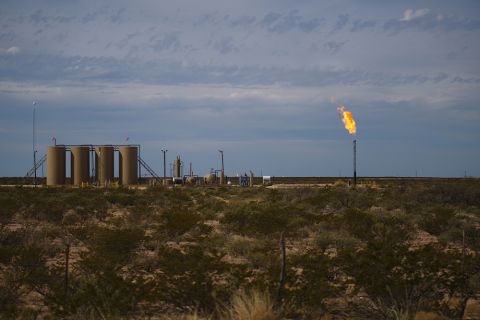
(Source: Cabot Specialty Fluids)
Shale-related problems continue to be one of the largest sources of nonproductive time and trouble cost during well construction. Operational problems range from bit-balling and cuttings dispersion to full-scale stuck drillstring and casing events because of wellbore caving and collapse. Problems manifest themselves mostly when using water-based muds (WBM) and can often be sidestepped by using oil-based mud (OBM) and synthetic-based mud (SBM).
The latter, however, come with their own set of drawbacks, including complicated offshore skip-and-ship operations, difficulties obtaining electrical/resistivity logs, high waste disposal costs, a low threshold for lost circulation through induced fractures, incompatibility with Portland cement, etc. Moreover, these muds do not perform well on fractured shale formations. It is therefore still highly desirable to identify water-based alternatives to OBM/SBM.
Naturally compatible
Both field experience and research show that fluids based on cesium and potassium formate brines are among the best shale-compatible water-based drilling and completion fluids available. Unlike other waterbased drilling and completion fluids, the shale-stabilizing properties of formate fluids are attributable to the inherent properties of the formate brine itself, rather than to additives. This has the great advantage that the shale-stabilizing properties do not deplete with time, and no complicated and/or expensive additive maintenance is required.
First, cesium (and to a lesser extent potassium) ions have a low level of hydration in solution, and the effective “shell” of water molecules they carry around them is easily removed. When such ions exchange at clay sites in shales, they can effectively shield the water-structuring negative potential of the clay platelets, while at the same time avoiding ion hydration/solvation stress buildup.
This allows these “inhibitive” ions to heavily reduce the swelling pressure acting in the clay fabric, delivering important benefits that range from the ability to avoid bit-balling and cuttings disintegration all the way to preventing clay swelling and fines mobilization in hydrocarbon- bearing reservoirs.
Stabilizing effect
Cesium and potassium formate fluids exhibit remarkable qualities for stabilizing wellbores in shale formations as confirmed by both detailed laboratory studies as well as field applications. Contrary to popular belief, wellbore instability has little to do with clay swelling.
Wellbores typically destabilize, irrespective of mud type and formulation, when the wrong mud pressure is applied. However, even when the correct mud pressure is used shale formations may still destabilize over time due to mud pressure transmission driven by mud overbalance. Pressure transmission “charges” the near-wellbore pore pressure in shale rocks, creating instability in near-wellbore zones with associated borehole caving and enlargement over time, and a plethora of knock-on problems that include stuck pipe, poor casing runs, poor cement displacement causing poor cement jobs and insufficient zonal isolation.
Formate fluids offer two main mechanisms to slow down—and in some cases even avoid—pressure transmission. First, concentrated formate solutions have high filtrate viscosity. This slows Darcy flow into the shale that causes the detrimental near-wellbore pore pressure elevation. Second, concentrated formate solutions generate high osmotic pressures opposite shales with lowersalinity pore fluids, allowing hydraulic flow into the shale to be offset by osmotic flow out of the shale if the shale acts as an osmotic membrane.
Offshore shale case study
How good the shale-stabilizing qualities of formate fluids are in comparison with other muds was shown recently in a comparative mud evaluation conducted on behalf of Maersk Oil. The company had been suffering from time-delayed wellbore instability problems in the Lark/Horda shale formation that was intersected while drilling Tor/Ekofisk wells in the Danish sector of the North Sea.
Drilling with either conventional WBM or OBM resulted in a limited trouble-free openhole time of only three to five days before the well started to cave and wellbore enlargement commenced. This resulted in operational problems ranging from trouble backreaming out of the hole and running casing to irreversible stuck pipe and necessity to sidetrack.
In a series of competitive tests, a 13.5-parts-per-gallon-mixed cesium/ potassium formate fluid showed minimum shale accretion and excellent cuttings integrity in dispersion testing. The fluid distinguished itself in particular, however, during pressure transmission tests and borehole collapse tests where it stood apart from all other muds, including new commercial high-performance WBM (HP-WBM) formations and modified OBM formulations.
Figure 1 shows the comparative pressure transient testing results, showing the formate fluid to be in a league of its own in its ability to delay the onset of instability caused by pressure transmission, with delay factors that were more than five times larger than those observed for the best HP-WBM systems. The formate fluid also delivered the strongest wellbore during the borehole collapse tests.

FIGURE 1. An overview is shown of absolute delay factors recorded during pressure transient testing by Maersk Oil for various mud systems indicating baseline performance by OBM and previous best HP-WBM performance by HP-WBM 1 and HP-WBM 4. The blue arrow indicates the step-change improvement observed with cesium/potassium formate fluid, which is clearly distinguished from the other results. (Source: Cabot Specialty Fluids)
Faster ROP with formate fluids
These results are fully validated by field experiences with formate fluids. Wells drilled from the late 1990s by Agip, Statoil, Kerr McGee and others all have shown excellent wellbore integrity in shales after extended periods of openhole time. These operators also observed a significant increase in ROP when comparing formate fluids to both conventional WBMs as well as OBM/SBM systems. This was most clearly demonstrated by a large number of wells drilled by Encana and others in the Montney Shale in Canada, where a potassium formate fluid drilled on average 30% to 40% faster in the shale than OBM systems (Figure 2).

FIGURE 2. Potassium formate brine drilling performance (blue) in days versus depth compared to invert OBM (red) in Montney Field B clearly shows the acceleration in drilling performance facilitated by the formate fluid. (Source: Cabot Specialty Fluids)
The hole-making benefits of formate fluids are derived from two mechanisms. First, it is possible to formulate higher density fluids with the brine by itself, resulting in low-solids/ solids-free fluids that reduce chip hold-down. Second, as indicated, formates can osmotically pull water from shales, creating a lubricating layer that prevents shale from sticking to bit cutters and allowing better hydraulic cleaning of the bit face.
Additional benefits that come into play when using formates are excellent lubricity on steel and shale formations, low hydraulic frictional pressure losses, excellent HP/ HT stability, ability to obtain exceptional resistivity/ electrical logs and not having to adopt zero discharge waste management in offshore operations. These advantages, in combination with the aforementioned shale stability benefits, make formate fluids excellent candidates for performance drilling applications.
References available. Contact Jennifer Presley at jpresley@hartenergy.com.
Recommended Reading
TC Energy’s Keystone Back Online After Temporary Service Halt
2024-03-10 - As Canada’s pipeline network runs full, producers are anxious for the Trans Mountain Expansion to come online.
Enbridge Announces $500MM Investment in Gulf Coast Facilities
2024-03-06 - Enbridge’s 2024 budget will go primarily towards crude export and storage, advancing plans that see continued growth in power generated by natural gas.
TC Energy's Keystone Oil Pipeline Offline Due to Operational Issues, Sources Say
2024-03-07 - TC Energy's Keystone oil pipeline is offline due to operational issues, cutting off a major conduit of Canadian oil to the U.S.
Post $7.1B Crestwood Deal, Energy Transfer ‘Ready to Roll’ on M&A—CEO
2024-02-15 - Energy Transfer co-CEO Tom Long said the company is continuing to evaluate deal opportunities following the acquisitions of Lotus and Crestwood Equity Partners in 2023.
Waha NatGas Prices Go Negative
2024-03-14 - An Enterprise Partners executive said conditions make for a strong LNG export market at an industry lunch on March 14.




